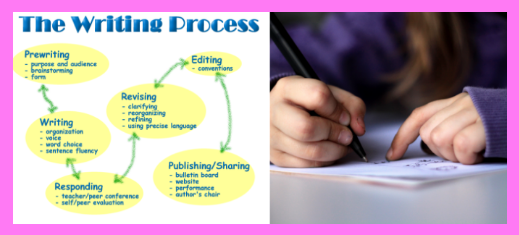


These are examples of activities one can run to prepare students to create public writing pieces. To see the difference between public writing pieces and write-to-learn pieces, go here.
Elements that Promote Good Public Writing:
- student choice of topic – enhances student ownership
- time to write in class – provide in-class support that helps students write, talk, and think in specific academic genres
- response – formative feedback that is provided to students as they write, not when they are finished
- good models – uses concrete examples to demonstrate key features of high quality work
- process approach – approach writing as a craft-like series of steps and stages that can be mastered over time
- supportive environment – positive learning environment that promote learning as a process, that value risks and mistakes
- real audience – real people (ideally outside school) who will read the writing. possible audiences include:
- your own class
- adult panels
- other students in other classes or schools
- special interest groups and orgs
- targets for advocacy
- experts in particular fields
- contest judges
Writing Process Stages: For another look at writing stages, go here.
- Before writing activities – Writing Activities – raises student interest, builds student knowledge
- Gathering information – researching and learning information related to writing topic
- Organizing – organizing information, steps, arguments so reader can follow writer’s lines of thinking
- Getting ideas down on paper
- Letting early drafts rest – permits writer to come back with fresh eyes
- Review the work – clear, concise, organized, communicates what’s intended, prune out extraneous information
- Revising – refine ideas and explanations
- Polishing – grammar, spelling, tone check
- Publishing – get student writing in front of a real audience where results matter

The elements and writing stages that support good public writing can be used to analyze, reflect upon, and refine projects that scaffold writing. The writing process stages can be used to organize project calendars that have public writing pieces as products.

Preparation Steps
- Analyze past projects that scaffold writing using stages and conditions listed above.
- Research and develop tools and strategies that enhance discovered strengths.
- Research and develop tools and strategies that bridge discovered gaps.
- Create project calendar that contains enough time to accommodate activities from writing stages students need to be successful at creating writing products.
- Gather resources to organize and store student writing and feedback.
Early Implementation Steps
- Facilitate writing activities that cover writing stages needed for student success. See above.
- Have students regularly set, achieve, and reflect upon goals that relate to writing products.
- Gather feedback from students to identify effective writing activities and to fine-tune activities.
Advanced Implementation Steps
- Use student feedback to identify most effective writing activities. Incorporate these activities into routines that appear in several projects to support student writing.
- Use observations and data to Identify common areas of writing need and design activities to bridge these gaps.
- Recruit authentic audiences to raise the stakes of writing pieces.
- Use technology to publish student writing in meaningful settings.

